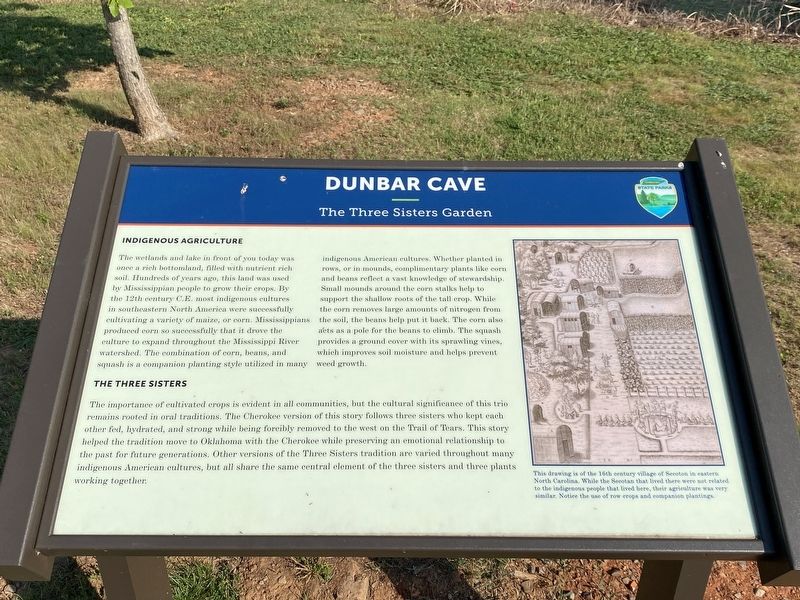Clarksville in Montgomery County, Tennessee — The American South (East South Central)
The Three Sisters Garden
Dunbar Cave
The wetlands and lake in front of you today was once a rich bottomland, filled with nutrient rich soil. Hundreds of years ago, this land was used by Mississippian people to grow their crops. By the 12th century C.E. most indigenous cultures in southeastern North America were successfully cultivating a variety of maize, or corn. Mississippians produced corn so successfully that it drove the culture to expand throughout the Mississippi River watershed. The combination of corn, beans, and squash is a companion planting style utilized in many indigenous American cultures. Whether planted in rows, or in mounds, complimentary plants like corn and beans reflect a vast knowledge of stewardship. Small mounds around the corn stalks help to support the shallow roots of the tall crop. While the corn removes large amounts of nitrogen from the soil, the beans help put it back. The corn also acts as a pole for the beans to climb. The squash provides a ground cover with its sprawling vines, which improves soil moisture and helps prevent weed growth.
The Three Sisters
The importance of cultivated crops is evident in all communities, but the cultural significance of this trio remains rooted in oral traditions. The Cherokee version of this story follows three sisters who kept each other fed, hydrated, and strong while being forcibly removed to the west on the Trail of Tears. This story helped the tradition move to Oklahoma with the Cherokee while preserving an emotional relationship to the past for future generations. Other versions of the Three Sisters tradition are varied throughout many indigenous American cultures, but all share the same central element of the three sisters and three plants working together.
Caption
Lower Right: This drawing is of the 16th century village of Secoton in eastern North Carolina. While the Secotan that lived there were not related to the indigenous people that lived here, their agriculture was very similar. Notice the use of row crops and companion plantings.
Erected by Tennessee State Parks.
Topics. This historical marker is listed in these topic lists: Agriculture • Native Americans • Parks & Recreational Areas.
Location. 36° 33.032′ N, 87° 18.289′ W. Marker is in Clarksville, Tennessee, in Montgomery County. Marker can be reached from the intersection of Old Dunbar Cave Road and Dunbar Cave Road. Touch for map. Marker is at or near this postal address: 401 Old Dunbar Cave Rd, Clarksville TN 37043, United States of America. Touch for directions.
Other nearby markers. At least 8 other markers are within walking distance of this marker. Dunbar Cave (a few steps from this marker); Affricanna Town (within shouting distance of this marker); a different marker also named Dunbar Cave (within shouting distance of this marker); a different marker also named Affricanna Town (within shouting distance of this marker); a different marker also named Dunbar Cave (about 300 feet away, measured in a direct line); 1933 Swimming Pool & Bathhouse (about 400 feet away); Roy Acuff (about 400 feet away); Wetland (about 500 feet away). Touch for a list and map of all markers in Clarksville.
Credits. This page was last revised on June 10, 2023. It was originally submitted on June 6, 2023, by Darren Jefferson Clay of Duluth, Georgia. This page has been viewed 74 times since then and 23 times this year. Photos: 1, 2. submitted on June 7, 2023, by Darren Jefferson Clay of Duluth, Georgia. • James Hulse was the editor who published this page.

